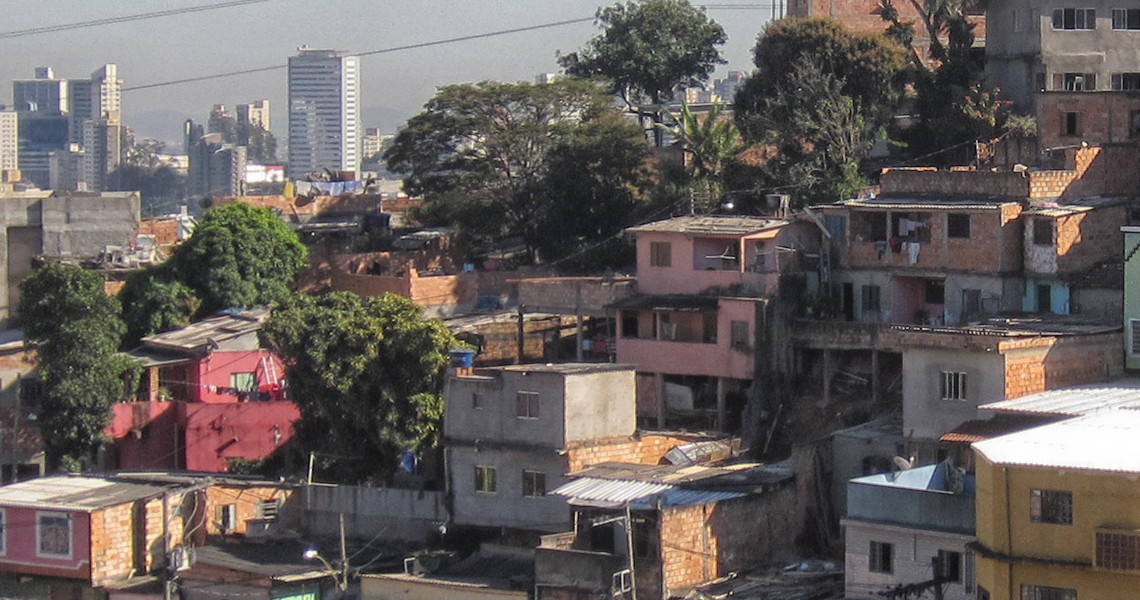Urban Health Social Epidemiologist Identifies Racial Health Inequalities in Brazil
“Revolutionary” Research Conducted in Partnership with Former Dornsife Visiting Scholar

9/26/2016 10:01:00 AM
Post-doctoral fellow Sharrelle Barber, ScD, MPH, has focused much of her research with the Urban Health Collaborative on the connections between race, place and health in the U.S. South. This summer, she took on a new challenge: applying her social epidemiological approach to study the health implications of residential segregation by class and race in Brazil. Early results from her work are striking, as race, place and health have rarely been discussed and studied there.
First Study to Explore Connections between Segregation and Health in Brazil
A presentation from a recent Dornsife visiting scholar, Leticia Cardoso, PhD, MS, inspired Barber’s work. Cardoso is part of a team that coordinates the Brazilian Longitudinal Study of Adult Health (ELSA-Brazil), at the Oswaldo Cruz Foundation (FioCruz) in Rio de Janeiro. The team is following more than 15,000 Brazilian civil servants to study the incidence and risk factors for chronic conditions, including cardiovascular diseases and diabetes.
Barber is analyzing the robust Brazilian ELSA dataset in a unique way, applying techniques she’s developed for work mapping residential segregation, race and cardio-metabolic risk factors in Jackson, Mississippi, the site of a longitudinal study on cardiovascular health. The Urban Health Collaborative and Office of International Programs at Drexel granted Barber an International Experience Award, to take on this first-of-its kind study of segregation and health in Brazil.
This summer, Barber spent six weeks in Brazil to gain a first hand understanding of the environments she is studying and share initial findings with her Brazilian research partners.
As she’d done on trips to Jackson, Mississippi, she visited higher and lower income areas, and took notes on the environment.
"Being there and seeing it added a dimension and depth to the work,” said Barber. "If you think about social ills that go along with economic inequality, it has more to do with fundamental causes than that people are bad."
Windshield Tour Adds Dimension to Research

In addition to exploring the city of Rio de Janeiro, Barber visited two of the ELSA-Brasil study sites: Salvador, Bahia in the Northeast region of Brazil (overseen by the Federal University of Bahia) and Belo Horizonte, Minas Gerais (run by the Federal University of Minas Gerais).
Her field work confirmed that Brazil is a country of stark contrasts between the very rich and very poor. In Rio, Barber travelled from the well known beaches and high rises of the affluent city center, 30 minutes north to the slums of Zona Norte, where she observed drastic differences in infrastructure, housing and safety.
Visiting Salvador, a poor city in Brazil’s poorest region, Barber found a rich culture - with samba, Afro-Brazilian religion and beautiful people, however there is “an ugliness of inequality,” she says. “The poor were mixed with the rich; slums next to high rises, very different than in other cities.”
In the suburban outskirts of Salvador, where 70-80 percent of the city’s black population resides, Barber observed that residents were forced to take one of three unreliable forms of transportation into the city: a small boat, a crowded bus, or an unreliable train.
Barber then journeyed to Belo Horizonte in the region of Minas Gerais, where the Urban Health Observatory is located at Federal University. There she met with Waleska Kaifa – a member of the Latin American Network for Urban Health co-founded by Drexel – and toured the city. “We went from slums to seeing helipads on houses and gated communities with security guards keeping people out." While favelas, or urban slums, are still common in Belo Horizonte, Barber noted that there seemed to be more social programs in the slum areas, and many programs were driven by community input.
"Segregation was different in each of the cities," Barber recalled. "Because I saw it, it makes the way I’m thinking about the research more real."
Brazilian Racial Segregation and Health Disparities Mapped Together
Back in Rio, Barber presented initial findings to the team at FioCruz.
Using techniques that link census data to the civil servant ELSA study, Barber looked at socioeconomic measures of segregation and created maps showing hotspots of high and low segregation alongside health differences. Early findings demonstrated racial segregation in Brazil that had never been quantified before. The study also identified a higher prevalence of both diabetes and hypertension in more segregated areas. A paper describing the research findings is pending publication.
Addressing Segregation as a Fundamental Cause of Health Disparities
If the root cause of health disparities is segregation, Barber says, corrective policies must be bold – to address larger structural factors that influence health. "We could go to neighborhoods and provide extra education or resources, but, if we think of residential segregation as fundamental cause, the place itself needs to be addressed,” she said. “Improve access to jobs, education, and other resources. Look not only at actions but inactions - where the absence of policy causes and perpetuates issues."
Barber described her Brazilian field tour as a transformative learning experience. “To be a black woman sharing this research in front of mostly white faculty at the top research institution in Brazil was powerful,” she said. “It meant a lot to be there.”